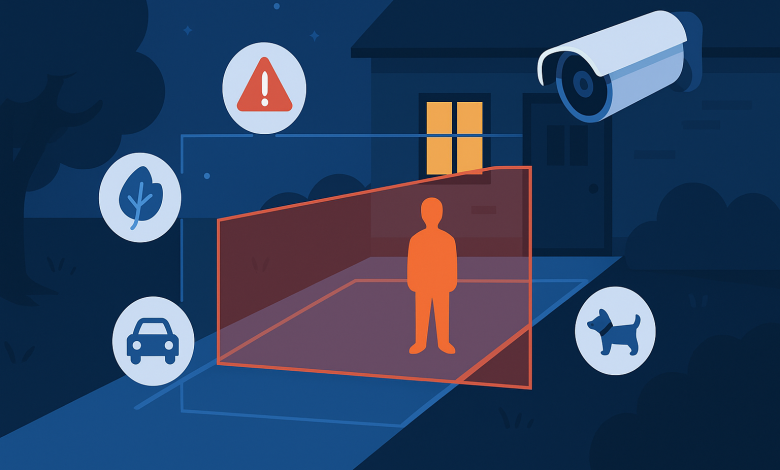
If your phone buzzes all the time because your outdoor security camera detected a tree leaf or a passing car, you are not alone. When the best outdoor security camera for peace of mind becomes a litany of false alarms, it can no longer provide that sense of security for very long. Even more problematic is that you may eventually stop paying attention to the notifications altogether, essentially nullifying the very point of having an outdoor security camera.
In this guide, I will go over the optimal settings, placement tips and real-world examples to reduce false alerts without missing out on the events that matter most.
Why Security Cameras Send So Many False Alarms
You cannot fix the problem without understanding why it is happening. The majority of today’s outdoor security cameras use motion detection, with the noteworthy exception of the 199 dollar Nest Cam and its 5 dollar per month Nest Aware service.
Most cameras rely on one of two systems:
- Pixel (image) difference detection, where the camera signals when enough pixels differ between consecutive frames.
- Infrared or heat detection, in which a camera detects changes in heat patterns generated by people, animals or vehicles.
Both systems can be activated by things that are not real dangers. Typical culprits include:
- Tree branches moving
- Light fluctuations from clouds or car headlights
- Bugs near the lens
- Pets walking through the yard
- Occasional rain or snow
When folks are shopping for the right outdoor security camera, there can be two main features that drive them: resolution or night vision. Those factors are important, but half the real-world experience depends on how well the camera handles movement, detection zones and smart filtering.
Begin With the Right Outdoor Security Camera Features
Better settings and placement can reduce false alerts, but a camera is still a camera. When you are in the market for a good outdoor security camera, it should feature technology to minimize useless notifications.
Intelligent Motion Detection and Object Classification
Smarter motion detection is a feature built right into many newer outdoor security camera models. Instead of treating all movements as being on the same level, they can recognize:
- People
- Vehicles
- Animals
- Packages
If you are able to program your camera to notify you only when it detects a person by your front door or a vehicle pulling into your driveway, you have already taken away much of the noise resulting from branches, cats and shadows.
Custom Activity Zones
With custom activity zones, you can draw boxes or shapes on the camera view in which detection will be counted while ignoring everything else. For example, you can:
- Pay attention just to the footpath up to the front gate.
- Forget about the street and sidewalk people pass along all day.
- Look at the driveway and garage door.
The outdoor security camera you choose should also have a mobile app that makes it easy to adjust the cut-in and customize motion zones.
Adjustable Sensitivity Levels
Sensitivity adjusts how easily the camera sends an alert. High sensitivity could mean it picks up every wiggle of leaves, while low sensitivity could mean that someone can walk near the fence without triggering it. A decent outdoor security camera will offer you a range of sensitivity steps, not just “low, medium, high,” so that you can tweak the behavior.
Outdoor Camera Position: Where You Place It Matters
No amount of smarts can completely fix poor placement. A foot higher off the ground and pointed slightly away from a roadway turned out to be one of the most significant improvements in cutting down false alerts in my own testing.
Mount Height and Angle
For most homes, 8 to 10 feet above the ground is a sweet spot in terms of mounting outdoor security cameras. That is high enough that you do not have to worry about grabbing the camera by accident but low enough for a good view of faces and details.
Instead of aiming the camera straight out, angle it a bit downward. A downward angle also cuts the sky in the frame, which reduces false alerts caused by changes in lighting or flying bugs. It helps the camera to better focus on people and vehicles moving toward your property.
Avoiding Busy Backgrounds
If your outdoor security camera is watching a busy street, major sidewalk or open area with people coming and going all the time, it is likely to have a hard time staying quiet. Each car, each cyclist, is now a possible alert.
Whenever possible:
- Do not aim the camera directly into traffic.
- Angle its position toward your door, gate or windows instead.
- Keep your primary zone of protection on your own side of the property line.
This little tweak can transform a camera that is constantly buzzing into an effective, focused security instrument.
Reducing Moving Foliage and Light Sources
The garden looks great with trees and plants, but it can be a nightmare for motion detection. Moving branches in the wind, especially at night when the wind is moving them right in front of a bright light on a house, create constantly changing pixels.
Try to:
- Keep large trees and shrubbery away from the main range of detection.
- Avoid placing the camera where it is blocked with thin leaves or branches.
- Watch for reflections from windows, vehicles or metal objects that may cause false triggers due to sunlight movements.
At night, ensure your lights are not doing the photographing for you. Beams strong enough to shine straight into the lens from porch lights or street lamps can produce flares and flicker, which to a camera will appear like motion once more.
Dialing In Motion Zones and Sensitivity
The rest of the adjustments take place digitally in the camera’s motion detection settings. Once your camera is in the right place, you are set up to jump into the app on the camera you have and turn the fine-tuning into a purely digital job.
Fer says to do the following:
- Open your outdoor security camera app and find something related to zones or motion areas.
- Begin with this rule: if you have only one zone, it should be surrounding an area where anyone has to go before they reach your front door. Remove all the busy spots like the street, neighbor yards or public sidewalks from the view of your camera.
- If you can have multiple areas, then you can have one for drop spots, front doors and side gates, each with its own alerts and without alerts you can get.
- You will help it to feel like your outdoor security camera is a guard, and not an omnipotent observer of a real-life Truman Show.
- Do not jump straight from maximum sensitivity to the lowest level. Instead, give it a week or even two to find the sweet spot between too many alerts and too few.
- Start with the medium-high setting on day one, then lower it on day two and see how many alerts you get in 24 hours.
- Lower it one more time if you still get hundreds each day only because the tree and the mailbox are both constantly in motion.
- When you find yourself in a sweet spot, stop adjusting. That is when a real person or vehicle should trigger the notification every single time they enter the camera’s frame, but background motion does not.
If your outdoor security camera has filtering options for different types of objects, it is generally recommended to use AI-based filters.
- Person and vehicle alerts are also an asset for driveway cameras.
- Backyard cameras could prioritize person detection to limit continual triggers from furry companions.
It is one of the best ways to make your setup feel more like the best outdoor security camera experience that it should be for you and your property.
Notification Schedules and Modes
Perhaps the number one grievance by consumers about outdoor security cameras is that guards are too loud when things get busy, and then effectively mute themselves exactly when you need them most. That is usually a schedule issue, not one of hardware.
Most cameras allow you to:
- Fully arm the camera at night.
- Set lower-level alerts during the day.
- Temporarily silence notifications when you are throwing a party or gardening.
Schedule your camera to send full alerts during times you would be unlikely to go outside, like late at night or early in the morning. You can instead rely on event history and live view during the day when you work from home, with fewer notifications.
Connectivity, Wi-Fi and Software Updates
Current detection, Wi-Fi technology and alert filtering with free Blackbox software: the Radenso XP comes preloaded with the latest in-house designed and tested antennae for enhanced sensitivity.
It is not always apparent, but the quality of your internet connection and camera software also play a role in alerts. Lack of a strong Wi-Fi signal can result in your footage being delayed and having corrupted frames or gaps, the latter sometimes confusing motion detection.
Position your router or mesh node near enough that you will get a good signal in your primary outdoor security camera locations. If that is not possible, look into purchasing a dedicated Wi-Fi extender for outdoor coverage.
Make sure you also regularly check for firmware updates. Manufacturers typically refine motion algorithms over time, so an older camera can end up being smarter at filtering out false alerts with a software update.
Real-World Placement Examples
For a more concrete sense of how to apply all this, here are some common setups and how you can deal with them.
Front Door Setup
Put the camera above, or off to the side of, the door and point it down at the entrance and steps. Confine the detection zone to just the doorstep and a piece of pavement in front, not the whole street. Utilize people and or package detection if possible.
Driveway or Garage Setup
Place the outdoor security camera to look down the length of the driveway but prevent the zone from extending to where your driveway risks distraction toward the main road. Enable vehicle and person detection. Set sensitivity so that only cars rolling into or out of your property set up alerts.
Backyard or Garden Setup
Aim the camera at doors, windows or gates instead of open areas with trees. If you have pets free-roaming your yard, try testing the animal detection settings or drop sensitivity until it is just the right level and use people detection for security.
Common Mistakes to Avoid
There are a few common errors that people make when they have issues with false alerts:
- Mounting the camera behind branches or fences that are swaying in the wind.
- Pointing directly at an active roadway or public sidewalk instead of keeping detection at the property line.
- Leaving the camera at maximum sensitivity because you feel that anything less and something will creep up on you in real life.
- Forgetting zone tools and leaving detection set for the entire frame.
- Skipping regular updates, which can mean sticking with bugs long after the manufacturer has patched them.
Steer clear of these errors and you are well on your way to peace of mind with a solid home security camera system based around the best outdoor security camera for your place.
Final Verdict: A Smart, Silent Guard For Your Camera
The Altruist is a clever atypical security system that prioritizes silence and discretion above all else.
But false alarms are not a sign that your outdoor security camera is worthless. They tend to signal that it is doing too much. Better placement, smarter zones, tuned sensitivity and advanced AI to detect what matters most all contribute to a better experience with your camera.
Think of it as training a guard. Early on, it shouts about everything. With a little training, it learns to bark only when someone is truly on your property or at your door. Get to that balance – where you do not have to hyper-schedule quite so much – and you can enjoy real peace of mind, knowing that an alert on your phone is something you probably should check.
FAQs
Why does my outdoor security camera pick up moving trees and shadows?
Most of them are pixel change detectors and things like tree branches or light changing patterns from clouds or car headlights can look like real motion. Simply diminishing the sensitivity, repositioning at an angle and leaving out trees or bright lights from within the detection zones will work.
What is the best height to install the best outdoor security camera?
A good rule of thumb is about 8 to 10 feet above the ground for most homes. It keeps the camera out of arm’s reach, but still records useful details like faces and license plates. Installing it at this height and tilting it slightly down also has the benefit of minimizing false alerts from objects moving far away.
How do activity zones help in decreasing false alerts?
Activity zones let you tell the camera exactly where to look for motion. By drawing zones only around your door, path or driveway and not including the street or a neighbor’s yard, you prevent the camera from responding to people and vehicles who are not actually on your property.
Is turning off notifications entirely during the day a good idea?
It is better to limit schedules instead of turning off notifications altogether. You may want your outdoor security camera to send fewer alerts during the day when there is more going on outside, and stronger alerts at night. That way you see important events, but you will not get exhausted by unending buzzing while at home.
Should I buy a new outdoor security camera to solve this problem of false alerts?
Not always. Many times, fine-tuning placement, sensitivity, zones and notification rules can slash false alerts on a camera that you already own. But if your camera is not smart enough to separate humans or vehicles from other types of movement, stepping up to a newer model with that functionality makes it much easier to maintain peace and the sense of security you are looking for.




